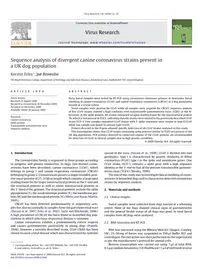
2009 Sequence analysis of divergent canine coronavirus strains present in a UK dog population PDF
Preview 2009 Sequence analysis of divergent canine coronavirus strains present in a UK dog population
Virus Research 141 (2009) 21–25 Contents lists available at ScienceDirect Virus Research journal homepage: www.elsevier.com/locate/virusres Sequence analysis of divergent canine coronavirus strains present in a UK dog population Kerstin Erles ∗, Joe Brownlie The Royal Veterinary College, Department of Pathology and Infectious Diseases, Hawkshead Lane, Hatfield AL9 7TA, United Kingdom a r t i c l e i n f o Article history: Received 15 August 2008 Received in revised form 18 December 2008 Accepted 22 December 2008 Available online 20 January 2009 Keywords: Canine coronavirus Spike protein Transmissible gastroenteritis virus Sequence analysis a b s t r a c t Forty faecal samples were tested by RT-PCR using coronavirus consensus primers to determine faecal shedding of canine coronavirus (CCoV) and canine respiratory coronavirus (CRCoV) in a dog population housed at a rescue centre. Seven samples were positive for CCoV while all samples were negative for CRCoV. Sequence analysis of five CCoV strains showed a high similarity with transmissible gastroenteritis virus (TGEV) at the N- terminus of the spike protein. All strains contained an open reading frame for the nonstructural protein 7b, which is not present in TGEV, indicating that the strains were related to the previously described CCoV strain UCD-1. Two samples contained CCoV strains with 5′ spike sequences most similar to type II CCoV while one sample was found to contain type I CCoV. Primers directed to the N gene allowed specific detection of all CCoV strains analysed in this study. This investigation shows that CCoV strains containing spike proteins similar to TGEV are present in the UK dog population. PCR primers directed to conserved regions of the CCoV genome are recommended for detection of CCoV in clinical samples due to high genetic variability. © 2009 Elsevier B.V. All rights reserved. 1. Introduction The Coronaviridae family is organised in three groups according to antigenic and genetic similarities. In dogs, two distinct coron- aviruses have been described; canine coronavirus (CCoV), which belongs to group 1 and canine respiratory coronavirus (CRCoV) belonging to group 2. Coronaviruses possess a single stranded, posi- tive sense genome of 27–31 kb in length which contains a large open reading frame for the major nonstructural proteins at the 5′ end and the structural proteins as well as minor nonstructural proteins in the 3′ third of the genome. The structural proteins include the spike glycoprotein (S), the small envelope protein (E), the membrane pro- tein (M) and the nucleocapsid protein (N) (Weiss and Navas-Martin, 2005). CRCoV has been detected predominantly in respiratory sam- ples but also occasionally in samples from the gastrointestinal tract (Decaro et al., 2007; Erles et al., 2003; Yachi and Mochizuki, 2006). A high prevalence of CRCoV has been found in kennelled dog pop- ulations in which infectious respiratory disease is common. Canine coronavirus exhibits a predominantly enteric tropism and causes gastroenteritis particularly in young dogs (Pratelli, 2006). However a recently described strain, CCoV CB/05 has been shown to cause a fatal disease which was characterised by systemic ∗ Corresponding author. Tel.: +44 1707 666486; fax: +44 1707 661464. E-mail address:
